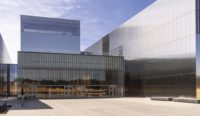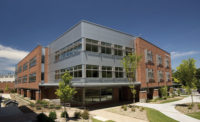The Case for Solid Metal Panels
-web.jpg?1635342010)
Hartford Hospital Bone & Joint Institute in Hartford, Connecticut. Photo courtesy of Metalwërks.
A brand-new healthcare facility aimed at improving the level of care in a community, complete with state-of-the-art technology and doctors at the forefront of their profession.
A distribution warehouse for an e-commerce giant that will add hundreds of jobs to the region and expand the company’s footprint and reach.
No matter the building, designing it requires ingenuity, vision, and creativity on the part of the architect. The job also comes with great responsibility. Architects must first ensure that the building will keep its occupants safe and secure, and that consideration begins with the exterior cladding. For starters, it must be durable—resistant to moisture, wind, and the forces of Mother Nature. It must also be energy efficient, utilizing new technologies and solutions that consider the building’s energy consumption over the long haul.
Even more importantly, the cladding must be made of safe materials that take toxicity levels and the potential for combustibility into account. At the outset, architects and planners must ask key questions:
• What if a fire were to break out inside the building?
• What if a vehicle near the building catches fire?
• How will the cladding react?
• Does the cladding have flammable properties that could cause flames to spread, endangering the structure and the people inside?
Finding the answers to these questions and determining the proper cladding material for the project is critical to ensuring a safe design. It is known as managing the life safety priorities of the design phase.
At the end of the analysis, there is one straightforward conclusion: Solid metal panels are safer as cladding than many other options available in today’s modern construction environment.
Choices and More Choices
Thanks to ongoing innovation in product development, architects and designers have many choices when it comes to a building’s exterior cladding.
An exterior insulation and finish system (EIFS) is a composite exterior cladding system designed to deliver protection from the elements. It is a layer of insulation and a finished surface, all in one integrated solution. EIFS typically consists of an insulation board that is attached to the substrate, a reinforced base coat, and a textured protective finish coat. Beyond delivering energy efficiency that outpaces other exterior cladding solutions, an EIFS also provides architects with design flexibility in the planning process.
Metal composite material (MCM) panels are “…formed by joining two thin metal skins to a polyethylene or fire-retardant core and then bonded under a precise temperature, pressure and tension,” according to the Metal Construction Association. Typically made of aluminum, MCM panels can offer greater flexibility and versatility when compared to solid metal panels of equal or similar thickness.
Consider the Trade-Offs
Despite what they offer, MCM panels and EIFS have a key component in their core that can be seen as a liability—plastic, foam, or another kind of synthetic material. Because of the presence of thermo-plastics that are often derived from petroleum feedstock, MCM panels and EIFS can ignite more readily than other materials and can even contribute to spreading a fire once it breaks out.
In 2017, the Grenfell Tower fire in London became the deadliest fire in that city in more than 30 years at the time. More than 70 died in the high-rise apartment building fire, and another 70 were injured. The investigation showed that the ACM panels and the insulation in the wall cavity on the high-rise tower utilized polyethylene polymer filler, which likely contributed to the spread of the flames. A year later, the government of the UK banned the use of combustible materials in the outside walls of residential buildings over a certain height.
Across the globe over the past 15 years, nearly ten other high rises with exterior walls that contained flammable materials suffered similar fires.
Applying a Decision Tree
Architects and specifiers should ask three critical questions when sourcing cladding materials to evaluate them for safety and sustainability:
1. Is the material inert to environmental effects and fire impacts?
2. Can the material be recycled when finished?
3. Is the material laminated or composite?
Solid metal is inert to fire and environmental effects such as high wind, water, and sun, making it durable for the long term and ensuring greater safety in emergencies, particularly in the event of a fire. Solid metal can also be recycled when finished and is more sustainable to fabricate, increasing the sustainability of the product overall. In addition, solid metal is homogenous. It is neither laminated nor a composite material. There are no plastics or toxic chemicals involved in fabrication, installation, or insulation.
One Word: Noncombustible
The National Fire Protection Association (NFPA) reviews products in two categories: combustible and noncombustible.
Exterior cladding made of combustible materials must undergo extensive and expensive testing to determine its reaction to fire. MCM panels and EIFS fall in this category. Their make-up delivers greater thermal efficiency, but these panels can be toxic to produce and can release toxins when burned.
Simply stated, solid metal panels used for exterior cladding are noncombustible in the eyes of NFPA. That means they can bypass most testing and are pre-approved for construction when it comes to safety regulations if all the exterior wall components are considered noncombustible.
Solid metal panels will not ignite. They contain no plastic or foam components, meaning no toxic or flammable additives. This means they will not burn off any toxic materials when exposed to a high temperature. In addition, they are engineered to weather naturally and are less prone to damage.
The Final Analysis: Safer and More Versatile
Architects who design a building are always engaged in a balancing act when it comes to sourcing materials for the building envelope. The ultimate goal is to select a product that meets or exceeds safety requirements, promotes energy efficiency, and contributes to a compelling design.
When it comes to fire risk and combustibility, solid metal panels win the day. Ones that are made of aluminum have a melting point of more than 1,200 degrees Fahrenheit. That number is even higher with stainless steel panels.
At the same time, they still provide architects with the flexibility to design something that inspires and turns heads.
Looking for a reprint of this article?
From high-res PDFs to custom plaques, order your copy today!






